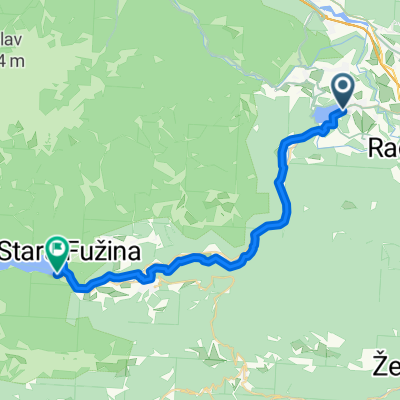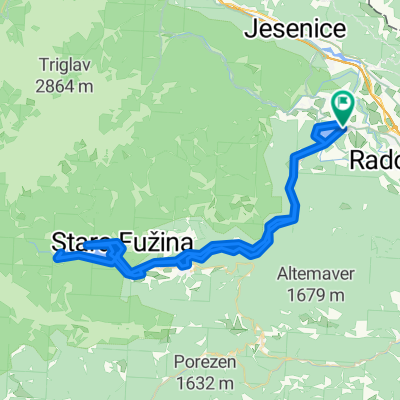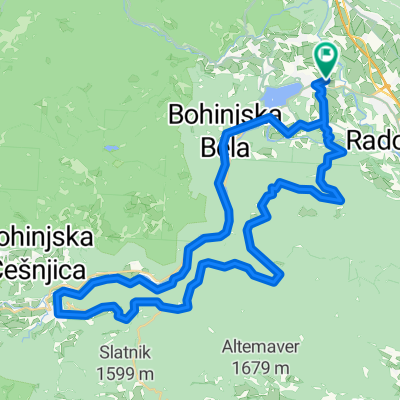B-D 16. Bled to Trenta
Un percorso ciclabile con partenza da Bled, Občina Bled, Slovenia.
Panoramica
Su questo percorso
Bus stops: Kranjska Gora (1130, 1730, 1830); Šumica; Mihov dom; Koča na Gozdu; Erjavčeva koča; Vršič; Izvir Soče K; Trenta
- -:--
- Durata
- 63 km
- Distanza
- 1.704 m
- Salita
- 1.556 m
- Discesa
- ---
- Velocità media
- 1.616 m
- Altitudine max.
Qualità del percorso
Tipi di percorsi e superfici lungo il percorso
Tipi di percorso
Strada
21,4 km
(34 %)
Pista ciclabile
11,3 km
(18 %)
Superfici
Asfaltato
59,8 km
(95 %)
Non asfaltato
0,6 km
(1 %)
Asfalto
48,5 km
(77 %)
Pavimentato (non definito)
11,3 km
(18 %)
Punti salienti del percorso
Punti di interesse lungo il percorso
Alloggio dopo 0 km
Heritage Hotel Starkl
Punto di interesse dopo 1,2 km
viewpoint
Punto di interesse dopo 1,6 km
viewpoint
Alloggio dopo 3,9 km
Hotel Bellini
Punto di interesse dopo 3,9 km
Bled Castle Blejski grad
Alloggio dopo 3,9 km
Gasthof Eberhard - Hof, Wirtshaus & Herberge
Punto di interesse dopo 14,7 km
Radovna Memorial
Punto di interesse dopo 39,3 km
Alpska Vasica
Punto di interesse dopo 40,4 km
New attraction in Kranjska Gora - 30 meters extremely beautiful long suspension bridge, located near Lake Jasna. From the bridge you have a wonderful view of the valley. Easily accessible
Punto di interesse dopo 40,7 km
Jezero Jasna
Punto di interesse dopo 45,4 km
Russian Chapel Ruska kapelica Wooden memorial chapel dedicated to Russian POWs who died building the Russian Road in 1916.
Punto di interesse dopo 50,3 km
Vršič Pass 1611m Slovenia's highest pass
Punto di interesse dopo 52,3 km
Supca viewpoint
Punto di interesse dopo 58,6 km
Julius Kugy was a mountaineer, writer, botanist, humanist, lawyer and officer of Slovenian descent. He wrote mostly in German. He is renowned for his travelogues from opening up the Julian Alps, in which he reflected on the relationship between man, nature, and culture.
Punto di interesse dopo 60,2 km
Juliana Alpine Botanical Garden 0830-1830
Punto di interesse dopo 60,4 km
Trentarske Fuzine - iron forges. The first written mention of Trenta was in a note on the Trebiščina alp dating back to 1326. At the beginning of the 16th century, Trenta was still covered with state-owned forests. Who and when first found iron ore in the valley remains unknown but the fact is that in 1576 the iron forges were erected, one opposite the existing church and the other near the entrance to the Zadnjica valley. Soon, the valley was swarming with army deserters, prison fugitives and free-spirited people, most of them from South Tirol, Tridento or Trent, after which the valley was eventually named. Still, the mines were not making much money, and were passed from owner to owner. One of them was Count Herman Attems, who commissioned the construction of a road to Bovec and settled in Trenta. He lived in castle, erected in the place of today’s priest's house. In 1690, he commissioned a church of Our Lady of Loretto. High costs of ore digging and transport made the mine unable to sustain the competition and around 1750 the Attems family sold it. The mine was closed down twenty years later, in 1778. A year after the iron forge near the church had ceased operation, it was studied and recorded by the first explorer of the Julian Alps, Balthasar Hacquet. The workers scattered around the neighbouring villages and towns. Some families stayed in Trenta, exchanging their miner's hammers with shepherd's sticks. In 1715 Trenta was visited by a priest, Venceslav Lucenperger, who stayed in the valley until his death in 1781. Lucenperger had a flock of about 100 sheep and shared the fate of the people of Trenta also after the mines had closed. The people of Trenta have repaid their priest by keeping his memory alive. Even today, the local inhabitants like to refer to him as »the late Trentar«. The thoroughfare to Bovec deteriorated soon after the closure of the mines, its role being taken by a network of paths and trails which connected the pastures and mountains surrounding the Trenta valley. The families of Trenta made their living by raising small cattle, wood harvesting and skidding and hunting. In the second half of the 19th century, people became more interested in the mountains and a number of Trenta inhabitants earned fame as excellent mountain guides. Life in the valley was hard, as the Kaiser Franz Joseph was quick to notice when he was travelling through the area on his way towards Triest in 1882. He offered the people of Trenta some land in Hungary, but the proud Trenta settlers flatly turned down his offer. In 1877 Julius Kugy first came to the valley. On his explorations of the Julian Alps, Kugy was accompanied by local guides, and he was so impressed by their skill and knowledge of mountains that he wrote about them in his books, presenting Trenta and its people to the world. In 1953, the Slovenian Alpine Association commissioned a Slovenian sculptor Jakob Savinšek to construct a monument to Julius Kugy that now stands at Na Turi in the Trenta valley. As a botanist, Kugy made friends with Albert Bois de Chesne, who had the right to hunt in Trenta. De Chesne bought some land in Trenta in 1925 and started working on what is known today as the Juliana Alpine Botanical Garden. Both Bois de Chesne and Kugy helped their guides and the inhabitants of the valley in many ways. The history of the First World War has recorded among the fiercest battles the names of Verdun, the shore of the river Somme, Ypres, Kras (Karst) and Bovec. In October 1917, after three years of battles in the area of the Soča river, combined Austro-Hungarian and German forces surprised the Italians with a counter-attack known as »The Miracle of Kobarid«, in which the winning troops used gas ammunition. Although the major battlefields were in the area of Bovec, only 10 km away from Trenta, the fiercest battles never affected it directly. During the First World War, Trenta received a large number of Russian prisoners who were building a road across the Vršič pass in horrible conditions. The Russian Chapel on the Gorenjsko side of the Vršič pass and the military cemetery in Trenta remain to the present day the only reminders of their suffering and death. During the war, Trenta provided temporary shelter and safe passage to local people from Bovec and its surroundings who were forced to leave their homes by order of Austrian authorities. Closer to the battelfields were Lepena valley and Soča village, where military cemetery could be found. After the Second World War, the image of Trenta changed completely, mainly as a result of depopulation and abandonment of goat and sheep grazing on the mountain slopes. The share of cultivated land fell from 28% to a mere 1% in the period 1900-1994. In 1880 Trenta had 380 inhabitants, but the number has been dropping ever since. In 1948, 281 people lived there; in 1991 there were only 120. Only three people lived in Zgornja Trenta in 1981, and today only the houses in Spodnja Trenta are permanently settled. The 2002 population count recorded 114 permanent inhabitants. Eighty years earlier, in 1921, 873 people lived in the village Soča, and in 2002 there were only 144. For decades on end, Trenta has ranked among demographically endangered areas. In the 1960s, Trenta experienced a tourist boom, and numerous holiday homes, spas and health resorts were built. Unfortunately, the temporary interest in Trenta was not sufficient to contain the drain of people from the valley and promote further development.
Alloggio dopo 63 km
Apartment Natasha
Continua con Bikemap
Usa, modifica o scarica questo percorso ciclabile
Vuoi percorrere B-D 16. Bled to Trenta o personalizzarlo per il tuo viaggio? Ecco cosa puoi fare con questo percorso su Bikemap:
Funzionalità gratuite
- Salva questo percorso tra i preferiti o in una raccolta
- Copia e pianifica la tua versione di questo percorso
- Sincronizza il tuo percorso con Garmin o Wahoo
Funzionalità Premium
Prova gratuita di 3 giorni o pagamento una tantum. Scopri di più su Bikemap Premium.
- Naviga questo percorso su iOS e Android
- Esporta un file GPX / KML di questo percorso
- Crea la tua stampa personalizzata (provala gratis)
- Scarica questo percorso per la navigazione offline
Scopri altre funzionalità Premium.
Ottieni Bikemap PremiumDalla nostra community
Bled: Altri percorsi popolari che iniziano qui
 Route to Bohinjsko jezero
Route to Bohinjsko jezero- Distanza
- 29,8 km
- Salita
- 921 m
- Discesa
- 827 m
- Posizione
- Bled, Občina Bled, Slovenia
 Biking from Bled to Bohinj
Biking from Bled to Bohinj- Distanza
- 77,2 km
- Salita
- 485 m
- Discesa
- 487 m
- Posizione
- Bled, Občina Bled, Slovenia
 Radovna
Radovna- Distanza
- 52,4 km
- Salita
- 625 m
- Discesa
- 628 m
- Posizione
- Bled, Občina Bled, Slovenia
 Arround Mezakla and lake Bled
Arround Mezakla and lake Bled- Distanza
- 56,4 km
- Salita
- 2.169 m
- Discesa
- 2.167 m
- Posizione
- Bled, Občina Bled, Slovenia
 Bled Kupljenik
Bled Kupljenik- Distanza
- 21,4 km
- Salita
- 510 m
- Discesa
- 510 m
- Posizione
- Bled, Občina Bled, Slovenia
 Route in Bled
Route in Bled- Distanza
- 60 km
- Salita
- 1.949 m
- Discesa
- 1.948 m
- Posizione
- Bled, Občina Bled, Slovenia
 Radovna Valley– bergauf Radovna Tal Runde von Lesce-Bled
Radovna Valley– bergauf Radovna Tal Runde von Lesce-Bled- Distanza
- 51,6 km
- Salita
- 631 m
- Discesa
- 639 m
- Posizione
- Bled, Občina Bled, Slovenia
 Bled - Bled 75 km
Bled - Bled 75 km- Distanza
- 73,6 km
- Salita
- 897 m
- Discesa
- 897 m
- Posizione
- Bled, Občina Bled, Slovenia
Aprila nell’app


